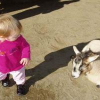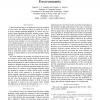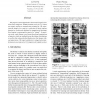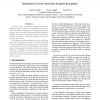CVPR
2005
IEEE
15 years 3 months ago
2005
IEEE
Classifying pictures into one of several semantic categories is a classical image understanding problem. In this paper, we present a stratified approach to both binary (outdoor-in...
CVPR
2005
IEEE
15 years 3 months ago
2005
IEEE
This paper presents a novel method for reconstructing complex 3D objects with unknown topology using silhouettes extracted from image sequences. This method exploits the duality p...
CVPR
2005
IEEE
15 years 3 months ago
2005
IEEE
Usually, object detection is performed directly on (normalized) gray values or gray primitives like gradients or Haar-like features. In that case the learning of relationships bet...
CVPR
2005
IEEE
15 years 3 months ago
2005
IEEE
Compared to scanned images, document pictures captured by camera can suffer from distortions due to perspective and page warping. It is necessary to restore a frontal planar view ...
CVPR
2005
IEEE
15 years 3 months ago
2005
IEEE
CVPR
2005
IEEE
15 years 3 months ago
2005
IEEE
Linear discriminant analysis (LDA) is a popular face recognition technique. However, an inherent problem with this technique stems from the parametric nature of the scatter matrix...
CVPR
2005
IEEE
15 years 3 months ago
2005
IEEE
We propose a novel approach to learn and recognize natural scene categories. Unlike previous work [9, 17], it does not require experts to annotate the training set. We represent t...
CVPR
2005
IEEE
15 years 3 months ago
2005
IEEE
Active contours or snakes have been extensively utilized in handling image segmentation and classification problems. In traditional active contour models, snake initialization is ...
CVPR
2005
IEEE
15 years 3 months ago
2005
IEEE
In earlier work, we proposed treating wide baseline matching of feature points as a classification problem, in which each class corresponds to the set of all possible views of suc...
CVPR
2005
IEEE
15 years 3 months ago
2005
IEEE
In this paper, we address the problem of detecting pedestrians in crowded real-world scenes with severe overlaps. Our basic premise is that this problem is too difficult for any t...




